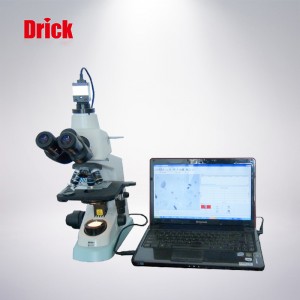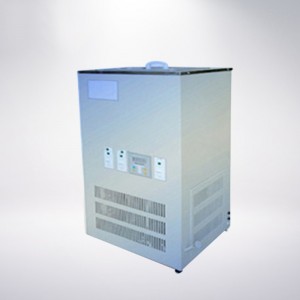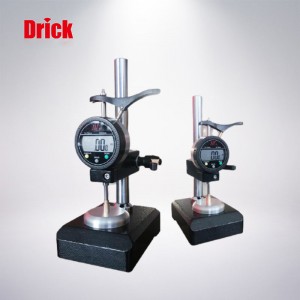DRK3600 Carbon Black Dispersion Tester
DRK3600 Carbon Black Dispersion Tester is used to detect the color and carbon black dispersion in polyolefin pipes, pipe fittings and mixed ingredients; these parameters can be established by measuring the size, shape, and dispersion of carbon black pellets The internal connection with macroscopic performance indicators such as mechanical properties, antistatic properties, and moisture absorption properties will have a positive impact on the quality assurance of plastic materials, production processes, and research and development of new products. At the same time, it will promote the rapid improvement of the technical level of enterprises and industries.
DRK3600 Carbon Black Dispersion Tester is used to detect the color and carbon black dispersion in polyolefin pipes, pipe fittings and mixed ingredients; these parameters can be established by measuring the size, shape, and dispersion of carbon black pellets The internal connection with macroscopic performance indicators such as mechanical properties, antistatic properties, and moisture absorption properties will have a positive impact on the quality assurance of plastic materials, production processes, and research and development of new products. At the same time, it will promote the rapid improvement of the technical level of enterprises and industries. This instrument complies with the international standard GB/T 18251-2019. The key components adopt the imported NIKON binocular microscope, high-resolution, high-definition CCD camera, and powerful software function support, which can quickly and accurately measure particles or particles. The whole process of the size and dispersion of the group is automated. The user only needs to realize the sample addition, and the software automatically realizes the collection of particle pictures, automatic storage, and automatic calculation of various parameters.
Technical Features:
★A wide range of particle size distribution, ranging from micron level to millimeter level.
★Imported Nikon biological microscope, equipped with 5 million pixel CMOS image sensor, the image resolution is greatly improved.
★It has the function of moving the ruler and can measure any two points.
★Automatically segment adhesive particles, click on the particle image to display the measurement parameters of the particle.
★Using USB2.0 data interface, the compatibility with microcomputer is stronger. The instrument is separated from the computer and can be equipped with any computer with a USB interface; both desktop, notebook and mobile PCs can be used.
★A single particle image can be saved.
★Very powerful data report statistics function. Support various forms of data result report format.
★The software adapts to various operating systems, such as WIN7, WINXP, VISTA, WIN2000, WIN 10, etc.
★Adapt to various resolution screens.
★The software is personalized and provides many functions such as measurement wizard, which is convenient for users to operate; the measurement results are rich in output data, stored in the database, and can be called and analyzed with any parameters, such as operator name, sample name, date, time, etc. The software realizes data sharing.
★The instrument is beautiful in appearance, small in size and light in weight.
★High measuring accuracy, good repeatability and short measuring time.
★Considering the confidentiality requirements of the test results, only authorized operators can enter the corresponding.
★Database reading and processing.
★Provide correction block, with correction function
Technical Parameter:
★Measurement principle: image analysis method
★Measuring range: 0.5μm~10000μm
★Measurement and analysis time: less than 3 minutes under normal conditions (from the beginning of the measurement to the display of the analysis result).
★Reproducibility: 3% (volume average diameter)
★The principle of particle size equivalence: equal area circle diameter and equivalent short diameter
★Statistical parameters of particle size: volume (weight) and number of particles
★Calibration method: through standard samples, different magnifications are calibrated separately, without interfering with each other
★ Imaging resolution: 2048*1024 (5 million pixel digital camera)
★Image size: 1280×1024 pixels
★Optical magnification: 4X, 10X, 40X, 100X
★Total magnification: 40X, 100X, 400X, 1000X
★Automatic analysis result content: dispersion grade, average particle size, number of particles, particle data corresponding to different particle size ranges (number, differential %, cumulative %), particle size distribution histogram
★Output format: Excel format, JPG format, PDF format, printer and other display methods
★Data report format: can be divided into two types: “picture data report” and “data distribution report”
★Communication interface: USB interface
★Sample stage: 10 mm×3 mm
★Power supply: 110-120/220-240V 0.42/0.25A 50/60Hz (microscope)
Working conditions:
★Indoor temperature: 15℃-35℃
★Relative temperature: no more than 85% (no condensation)
★It is recommended to use AC power supply 1KV without strong magnetic field interference.
★Because of the measurement in the micron range, the instrument should be placed on a sturdy, reliable, vibration-free workbench, and the measurement should be performed under low dust conditions.
★The instrument should not be placed in places exposed to direct sunlight, strong winds or large temperature changes.
★. The equipment must be grounded to ensure safety and high precision.
★The room should be clean, dust-proof, and non-corrosive gas.
Configuration List:
1. One host of carbon black dispersion tester
2. 1 power cord
3. Camera 1
4. Camera communication line 1
5. 100 slides
6. 100 coverslips
7. Standard sample calibration sheet 1 copy
8. 1 pair of tweezers
9. 2 dovetail clips
10. 1 copy of manual
11. 1 softdog
12. 1 CD
13. 1 copy of certificate
14. Warranty card 1
Working Principle:
The carbon black dispersion tester combines modern electronic technology with microscope methods. It uses a camera to capture the image of the particles magnified by the microscope. , Perimeter, etc.) and morphology (roundness, rectangularity, aspect ratio, etc.) to analyze and calculate, and finally give a test report.
The optical microscope first amplifies the tiny particles to be measured and images them on the photosensitive surface of the CCD camera; the camera converts the optical image into a video signal, which is then transmitted via the USB data line and stored in the computer processing system. The computer recognizes the edges of the particles according to the received digitized microscopic image signals, and then calculates the relevant parameters of each particle according to a certain equivalent pattern. Generally speaking, an image (that is, a field of view of the imager) contains a few to hundreds of particles. The imager can automatically calculate the size parameters and morphological parameters of all particles in the field of view, and make statistics to form a test report. When the number of particles that have been measured is not enough, you can adjust the stage of the microscope to switch to the next field of view, continue testing and accumulate.
Generally speaking, the measured particles are not spherical, and the particle size we call refers to the equivalent circle particle size. In the imager, different equivalent methods can be selected according to customer needs, such as: equal area circle, equivalent short diameter, equivalent long diameter, etc.; its advantage is: in addition to particle size measurement, general topographic feature analysis can be performed. Intuitive and reliable.
Products categories
-

Phone
-

E-mail
-

Whatsapp
-

Top








